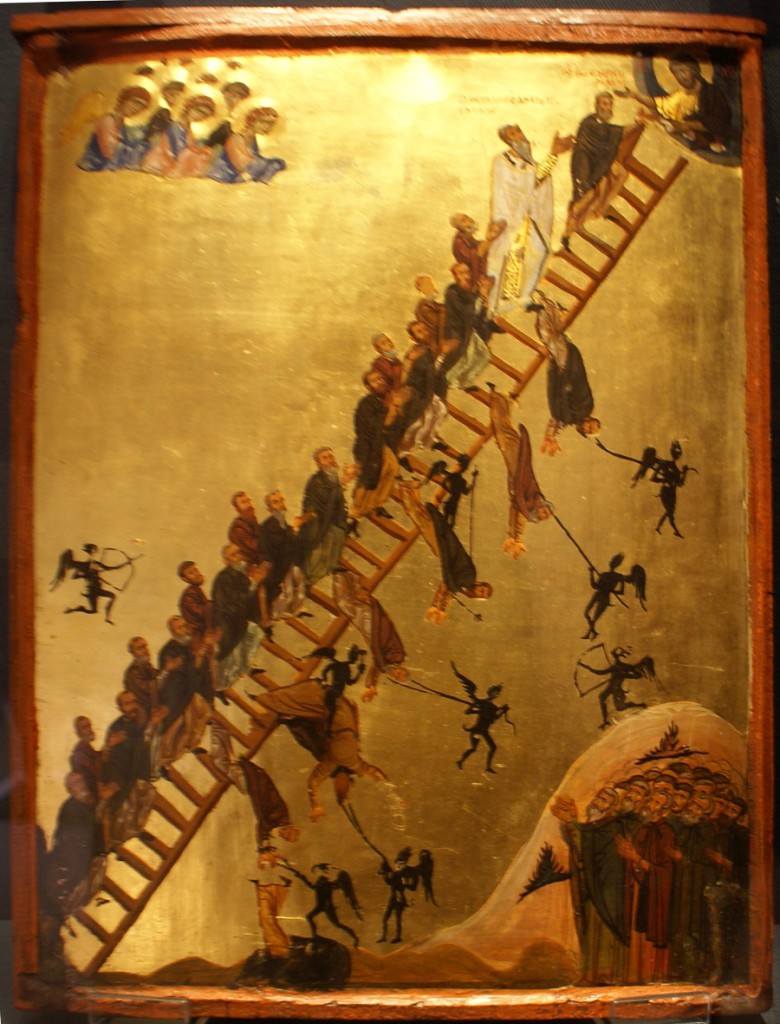
Sunday of St. John of the Ladder, March 22, 2015
Rev. Fr. Andrew Stephen Damick
In the Name of the Father and of the Son and of the Holy Spirit, one God. Amen.
What does a sixth century monk living on Mount Sinai have to teach us about evangelism?
That is the question I asked as I pondered the continuation of our series on evangelism and the Sundays of the Triodion. We come now to the Sunday of St. John Climacus—John of the Ladder.
John was a sixth century monk on Mount Sinai, who became the abbot of the ancient monastery nestled at the foot of the mountain. He is best known for his book The Ladder of Divine Ascent, from which he gets his name “John of the Ladder” or “John Climacus,” as Κλίμακος is Greek for “ladder.”
This book is a guide to the spiritual life for monks, and it is one of the most popular and famous of all such works, read at Orthodox monasteries everywhere. But its wisdom has been accepted outside of the monastic context as applicable for all Christians, though of course it is not applied in exactly the same way outside the monastery as it is inside.
The book is divided into thirty “steps,” each chapter a rung on the ladder that leads the Christian to the heavenly kingdom. The chapters have titles like “On exile” or “On that clamorous mistress, the stomach” or “On holy stillness.”
There is no “step” entitled “On evangelism” nor even “On the Gospel.” So not much we can say here, right? Well, you know me too well to believe that. There is of course much we can say here.
First, we should say why it is that there is no “step” with such a name. It is obvious that most Orthodox monks and nuns are not evangelists in the sense that we usually think of evangelists—people going out into the world to preach the good news of Jesus Christ to others. Most of them stay in their monasteries and only rarely go out.
But that is actually not true of all of them. There are traditional, authentic forms of Orthodox monasticism in which there is a great deal of interaction between the monastics and those around them. Not all monasteries are out in the desert or in a secluded forest. At its height, the city of Constantinople had many monasteries inside the city limits. Monks and nuns would have been common sights on the streets.
And it is also true that some monasteries originally built in secluded places had whole cities grow up around them. That is the case with, for instance, Holy Trinity / St. Sergius Monastery in Russia. It started out in the woods. Now it’s the center of a city.
But what about these monastics who don’t have much interaction with the world? How are they witnesses to evangelism?
First, we should not undervalue the power of prayer. I think we often act as though prayer is just an added-on bonus when we’re trying to get things done. “Yes, let’s make sure we pray, and then go do the real work.” No, prayer is real work. And monks and nuns are people who really pray.
The average Orthodox monastic spends eight hours every day in church praying, and often many hours privately in the cell praying, in addition to all the work they have to do just to keep things going at the monastery.
And prayer is powerful. I often think things would be much worse if they weren’t there praying for us. I’ve even seen several inexplicable answers to prayer during this Lent myself—hearts that I had basically written off as hardened were changed. I still don’t understand it. But I have no doubt that it is because of prayer.
So we should thank monks and nuns for their prayers. Their prayers are sustaining us. Their prayers are the means through which God is softening hardened hearts, protecting the innocent, guiding the straying, holding fast the desperate and the struggling, and so forth.
However, in addition to their prayers which actually do work to evangelize, there is something that monastics can teach us that is vital for our own evangelism. What they can teach us is what is covered by St. John in the first “step” of The Ladder.
And what is that first “step”? It is called “On renunciation of the world.” Its title in Greek, Περί αποταγής, translates to “On renunciation.” But of course it is “the world” which we are speaking of here. And αποταγής has the literal sense of arranging yourself away from something. And that something is “the world.”
Monastics have left the world. That is one of the reasons they wear black. They are dead to the world. And it is also one of the reasons why clergy also wear black. We are dead to the world. We have left it. We have arranged ourselves away from it. We have renounced it.
This is a critical first step not only for our own salvation but also for evangelism. In evangelism, we invite people into this holy church, into this holy life. But if we do not have the sense that we are actually moving them from one place into another in doing so, it is kind of pointless.
Coming into the Church means leaving the world behind. You cannot live in both places at once. And you also cannot import the world into the Church. Its ways and its priorities and preferences are not appropriate here. They make no sense here. This is the Kingdom of God, not the Kingdom of Man.
If you see distress and trouble in a church, you can be sure it is because those involved have tried to bring the world’s ways into the Church. And if you see people outside the Church who do not wish to come in, it either because the church they are looking at is following the world’s ways, and so they do not see how it is different, or it is because they do not want to change from the world’s ways to the Church’s ways. They do not want to renounce the world.
So Church means renunciation of the world. And that is necessary for evangelism because we have to have a clear-eyed sense that the Church is not the world. Being in the Church means renouncing the world, whether you are a monk, nun, priest, bishop or even a newborn baby being baptized. The beautiful thing about monastics and their renunciation of the world is that they model for us so clearly what that means. Their way of doing it is not the only way, but it is a very good way. We should all consider ourselves blessed that monks and nuns exist, and we should speak about monasticism to our friends and our children as something very desirable. “Perhaps you will grow up someday to be a monk, son! We would all be so blessed.”
Yet we may also ask whether renunciation of the world means that we are retreating into a self-satisfied club for holy people. Yes, we invite them in, but until they become “one of us,” we want nothing to do with them. So is renunciation of the world a rejection of the world?
No, of course not. Just as the Son of God, Who is wholly “other” from the world, came into the world to save the world because of His love for the world, then we also do the same. Indeed, it is only in renunciation of the world that we can actually love the world! It’s only when we don’t need the world any more and live by its rules any more that we can have compassion on the world.
Why? It’s because renunciation of the world grants us freedom. And freedom is what makes it possible to love. When you have to do something for someone because of a need you have or because you are constrained, it is not love. But when you are free, then what you do for that person is love. Then what you do is a gift.
And there is no greater gift than to bring someone here, to encounter our Lord Jesus Christ. And so we renounce the world, because we love the world, because God so loved the world.
To our God Who came into the world to save the world, with His the Father and the Holy Spirit, be all glory, honor and worship, now and ever, and unto ages of ages. Amen.



